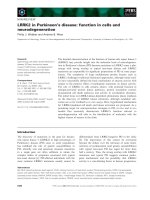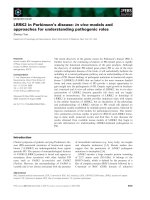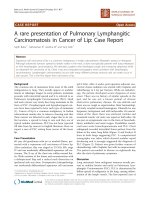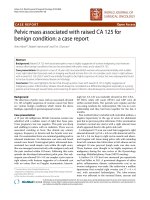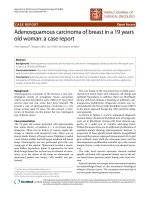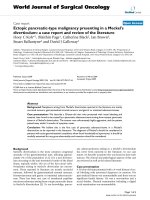báo cáo khoa học: " Amyotrophic lateral sclerosis-motor neuron disease, monoclonal gammopathy, hyperparathyroidism, and B12 deficiency: case report and review of the literature" potx
Bạn đang xem bản rút gọn của tài liệu. Xem và tải ngay bản đầy đủ của tài liệu tại đây (318.82 KB, 7 trang )
CAS E RE P O R T Open Access
Amyotrophic lateral sclerosis-motor neuron
disease, monoclonal gammopathy,
hyperparathyroidism, and B12 deficiency: case
report and review of the literature
Richard A Rison
1,2*
, Said R Beydoun
2
Abstract
Introduction: Amyotrophic lateral sclerosis (the most common form of motor neuron disease) is a progressive and
devastating disease involving both lower and upper motor neurons, typically following a relentless path towards
death. Given the gravity of this diagnosis, all efforts must be made by the clinician to exclude alternative and more
treatable entities. Frequ ent serology testing involves searching for treatable disorders, including vitamin B12
deficiency, parathyroid anomalies, and monoclonal gammopathies.
Case presentation: We present the case of a 78-year-old Caucasian man with all three of the aforementioned
commonly searched for disorders during an investigation for amyotrophic lateral sclerosis.
Conclusions: The clinical utility of these common tests and what they ultimately mean in patients with
amyotrophic lateral sclerosis is discussed, along with a review of the literature.
Introduction
Amyotroph ic lateral sclerosis (ALS) is a progressive and
devastating neurodegenerative disorder that affects pri-
marily motor neurons, and is the most common type of
motor neuron disorder. Because of the near-uniform
‘kiss of death’ implications that a diagnosis of ALS car-
ries, all efforts must be made to exclude alternative diag-
noses. Typical investigations look for a ny potential
treatable cause of the patient’s condition. In addition to
electrodiagnostic studies, the usual investigations include
neuroimaging studies to exclude anatomic structural
processes such as cervical my elopathies, and typical
laboratory investigations to search for any potential trea-
table metabolic abnormality. In particular, among the
most common laboratory tests used are those for vita-
min B12 levels (to rule out subacute c ombined degen-
eration), parathyroid hormone levels (to rule out
hyperparathyroidism), and serum protein electrophoresis
with immunofixation (t o rule out multiple myeloma or
monoclonal gammopathy of undetermined significance
(MGUS)).
Case presentation
A 78-year-old Caucasian man presented to our hospital
with a history of weakness in the left arm and shoulder,
with discomf ort and difficulty dressing himself, for the
past one and a half months. Initially he had attributed
his issues to a prior rotator cuff injury. He then noted
progressive shrinking in the muscle s of his left arm and
hand with decreased grip strength (overall he felt that
he lost about 80% strength in his left arm) and devel-
oped uncomfortable ‘charley horses’ (painful spasms or
cramps) in his left leg. There were no sensory, swal low-
ing, or visual issues, and he denied having experienced
any head or neck trauma. His medical history was sig-
nificant for hypertension, coronary artery disease,
hypercholesterolemia, hypothyroidism, and peptic ulcer
disease.
Results of a neurolo gical examination showed a trophy
in the left biceps and deltoid and also the left first dorsal
interossei (DI) muscle. Fasiculations were noted in the
left forearm and left first dorsal interossei. Strength
* Correspondence:
1
Neurology Consultants Medical Group, Presbyterian Intercommunity
Hospital, Whittier, CA, USA
Full list of author information is available at the end of the article
Rison and Beydoun Journal of Medical Case Reports 2010, 4:298
/>JOURNAL OF MEDICAL
CASE REPORTS
© 2010 Ri son and Beydoun; licensee BioMed Central Ltd. This is an Open Access a rticle distributed under the terms of the Creative
Commons Attribution License (http://creativecommons. org/licenses/by/2.0), which permits unrestricted u se, distributio n, and
reproduction in any me dium, provided the original work is properly cited.
testing results, using Medical Research Council ( MRC)
grades, were as follows: left biceps 4/5, deltoid 4/5, and
diminished grip strength 4/5. Strength testing in the left
abductor digiti minimi (ADM) was 5-/5, left flexor digi-
torumprofundus(FDP)1and2was5-/5,leftextensor
carpi radialis longus (ECRL) 4+/5, and 4/5 in the left
infraspinatous. Diminished grip strength (4/5) of the left
hand was a lso noted. N ormal strength testing (5/5) was
noted in the right arm and bilateral lower extremities.
Deep tendon reflexes were 1/4 in the left brachioradialis,
biceps, and triceps and 2/4 for others. His toes were
downgoing bilaterally. A mild gait imbalance was
observed. His sensory examination was completely
intact. No coordination deficits were seen. No cranial
nerve deficits were observed except for mild to ngue fas-
ciculations. His speech was fluent without dysarthria or
dysphasia.
An electrodiagnostic study performed the same week
showed low amplitudes in the left upper extremity
motor nerve compound muscle action potentials with
intact sensory nerve action potential responses. There
was no evidence of any abnormal temporal dispersion
or conduction block in multiple nerves tested. There
were 1-2+ fibrillation potentials and positive sharp
waves in the left deltoi d, triceps, biceps, flexor carpi
radialis (FCR), first DI, tibialis anterior, and bilateral gas-
trocnemius medial heads. His tongue showed a discrete
firing pattern without abnormal resting activity.
The results of neuroimaging studies of the spine
revealed age-related degenerative joint and disc disease
with spondylosis, but nothing that was felt would
account for his clinical condition. The working diagnosis
at thi s point was motor neuron disease (MND) probably
secondary to ALS (or ‘ clinically possible ALS’, via El
Escorial criteria).
Further laboratory investigations revealed a monoclo-
nal gammopathy (IgGl subtype) (2,019 mg/dL, with the
normal range being 694 to 1618 mg/dL) ( to l ratio of
1:2, w ith the normal ratio being 2:1) via both serum pro-
tein electrophoresis and serum immunofixation with leu-
kopenia and anemia (moderate normochromic
normocytic) along with B12 d eficiency (116 pg/ml).
Homocysteine was elevated (43.2 μmol/L, with the nor-
mal level being <11.4 μmol/L). Parietal antibody test
results w ere positive (1:80, with normal results being
<1:20) and an intrinsic factor antibody test result was
positive, and for these reasons it was felt that our pat ient
was B12 deficient. His erythrocyte sedimentation rate
(ESR) was slightly elevated at 40 mm/hour (the normal
range being within 0 to 20 mm/hour) but an anti-nuclear
antibody screen test result was negative. It was therefore
felt that the elevated ESR was due to anemia and/or
monoclonal gammopathy rather than an underlying
autoimmune process. Motor and sensory neuropathy
panels and paraneoplastic panel test results were
negative.
In order to exclude any potentially treatable causes of
MND, our patient underwent a bone marrow biopsy to
exclude any plasma cell dyscrasia. The results showed
hypocellular marrow with a hematopoietic cellularity of
20-40% (overall 30%) with no evidence of a ny granu-
loma or lymphoma, or tumor. Immunophenotyping data
did not show any evidence of neoplasia. There was no
evidence of any myeloproli ferative disorder. Our patient
also underwent a colonoscopy, which showed multiple
polyps but no evidence of any tumor. Our patient was
given B12 supplements via injection by a hematologist,
with a diagnosis of monoclonal gammopathy of undeter-
mined significan ce (MGUS), B12 deficiency, and perni-
cious anemia.
Our patient’s symptoms progressed to weakness in the
left shoulder with increasing weakness in the left arm,
and he underwent subsequent re-evaluation at a local
university neuromuscular department approximately 2
months later. The re-examination showed atrophy in
the bilateral spinati (left > right) along with persistent
atrophy in the left first DI, left thenar, and left deltoid
and biceps. Strength testing showed deltoid less than
antigravity with 4-/5 biceps, 4-/5 triceps, and wrist
extensors l ess than gravity on the left side with an
inability to extend the fingers. Wrist flexion and finger
flexion results were 4+/5 and interossei 3/5. In the right
upper extremity the thenar group was 4-/5, infraspina-
tous 4/5, supraspinatous 4/5, deltoid 5-/5, biceps 5-/5,
and the pectoralis 4-/5. The forearm muscles and hand
muscles on t he right side were in the 4+ to 5- range.
Fasiculations were noted in the upper extremity muscles
in a scattered distribution, predominately proximally.
A repeat electrodiagnostic study preformed approxi-
mately three to four weeks later revealed act ive denerva-
tion in multiple myotomes in both the upper a nd lower
extremities with chronic denervation. Motor axonal loss
changes were noted without conduction block.
Further laboratory test results that week included the
following: parathyroid hormone (PTH) was elevated (155
pg/mL, normal range 10 to 65 pg/mL) and the calcium
level was normal (9.6 mg/dL, normal range 8.8 to 10.3
mg/dL). Our patient ’ s renal function was normal. Unfor-
tunately, 25-hydroxy vitamin D levels were not tested.
The universi ty diagnosis at that time was ‘motor neu-
ron disease confounded by monoclonal gammopathy
and possible hyperparathyroidism’. This corresponded
with the El Escorial criteria classification of ‘clinically
probable laboratory supported ALS’ .Atrialofintrave-
nous immunoglobulin was considered for our patient,
but not recommended pending further evaluation.
Our patient was seen by an endocrinologist who made a
diagnosis of possible hyperparathyroidism (normocalcemic
Rison and Beydoun Journal of Medical Case Reports 2010, 4:298
/>Page 2 of 7
hyperparathyroidism), and an ultrasound st udy of the
thyroid and parathyroid glands was performed one month
later, showing a coarsened texture of the thyroid parench-
yma consistent with diffuse pathology. However, no focal
mass was seen. An enlarged parathyroid gland was not
detected.
In light of the dire prognosis that MND carries, and
the plausibility of hyperparathyroidism causing the
MND, consultation with a vascular surgeon was
arranged for consideration of a parathyroidectomy. At
last known follow-up our patient had continued to
deteriorate.
Discussion
ALS is a progressive and devastating neurodegenerative
disorder that affects primarily motor neurons. It is the
most common type o f motor neuron disorder. T he
characteristic form of this disease features the simulta-
neous presence of both upper motor neuron (UMN)
and lower motor neuron (LMN) signs, with progression
from one region of the neuraxis to the next. Many cases
of ALS will begin with the LMN form and then with
time progress to show UMN involvement. Most ALS is
sporadic, and men tend to develop ALS more often than
women with a male/female ratio of about 2:1. The inci-
dence of the disease increases with age, with a peak
occurrence between 55 and 75 years of age [1]. Treat-
ment is symptomatic, with riluzole extending survival by
12% [2]. Death, usually from respiratory compromise,
occurs approximately three years after o nset of symp-
toms [1].
Because of the near-uniform ‘kiss of death’ implica-
tions that a diagnosis of ALS carries, all efforts must be
sought to exclu de alternativ e dia gnoses. Typical investi-
gations look for any potential treatable cause of the
patient’s condition. In addition to electrodiagnostic stu-
dies, investigations usually include neuroimaging studies
to exclude anatomic structural processes such as cervical
myelopathies, and typical laboratory investigations to
search for any potential treatable metabolic abnormality.
In particular, among the most common laboratory tests
ordered are ones for vitamin B12 levels (to rule out sub-
acute combined degeneratio n), parathyroid hormone
levels (to rule out hyperparathyroidism), and serum pro-
tein electrophoresis w ith immunofixation (to rule out
multiple myeloma or MGUS).
Gammopathies and motor neuron disease
There have been various reports of patients with both
monoclonal gammopathy and MND (see below). How-
ever, before a discussion of this it is useful to review the
basic nomenclature, prevalence, and terminology. Lym-
phomas such as multiple myeloma and its precursor
MGUS are in a different category to the myeloproliferative
disorders/neoplasms (MPN). Myeloproliferative disorders/
neoplasms include chronic myelogenous leukemia, poly-
cythemia vera, essential thrombocythemia, primary myelo-
fibrosis, chronic neutrophilic leukemia, chronic
eosinophilic leukemi a/hypereosinophilic syndrome and
mast cell disease. Myeloproliferative disorders/neoplasms
may be diagnosed by morphological aspects, cytogenetics
and fluorescence in situ hybridization in bloo d and bone
marrow. Serum protein electrophoresis with immunofixa-
tion is useful to rule out multiple myeloma or MGUS
(though does n ot necessarily exclude MPN). Alexianu et
al. [3] provide a further review; monoclonal antibodies are
produced by expanded single B-cell clones and are var-
iously known as monoclonal protein, M protein, M com-
ponent, monoclonal gammopa thy, or paraprotein. They
are classified as IgM, IgG, IgA, IgE, or IgD according to
the heavy chain class. Monoclonal gammo pathy can be
associated with non-malignant or malignant lymphoproli-
ferative B-cell disorders. The non-malignant monoclonal
gammopathies have been referred to as ‘monoclonal gam-
mopathies of undetermined significance’ ,buttheterm
‘n on-malignant monoc lonal gammopa thy’ is preferred.
Non-malignant monoclonal gammopathy is differentiated
from malignant monoclonal gammopathy by a lower level
of serum M protein, low or unde tectable level of M p ro-
tein in the urine, absence of other signs of systemic disease
such as lytic bone lesions, anemia, hypercalcemia, or renal
insufficiency, and fewer than 10% plasma cells or absence
of lymphoid aggregates in the bone marrow. Monoclonal
antibodies are found in 10% of p atients with peripheral
neuropathy of otherwise unknown etiology [4]. Most IgM
monoclonal gammopathies associated with neuropathy
exhibit autoantibody reactivity to neural antigens, but such
autoantibody activity has not been associated with IgG or
IgA monoclonal gammopathies. The prevalence of mono-
clonal gamm opathy in the adult population is approxi-
mately 1%. Among patients older than 70 years of age, the
frequency of monoclonal gammopathy was found to be
3%. The distribution of heavy chain classes in patients
with non-malignant monoclonal gammopathy is 73% to
86% IgG, 0% to 14% IgM, and 11% to 14% IgA [3].
The literature suggests that patients with MND may
have a higher incidence of lymphoproliferative disorders
(LPD). The association between MND and LPD could
be coincidental, but LPD seems to be disprop ortionat ely
frequent in patients with MND compared to the popula-
tion in general [5]. Despite an initial report suggesting
that major improvements occurred sometimes coinci-
dentally with reductions in paraprotein levels using pre-
dnisone, cyclophosphamide, chlorambucil and plasma
exchange treatments even in some patients who had the
clinical appearance of ALS [6], most of the subsequent
literature argues against this, with less than successful
trials using various immunomodulatory agents and
Rison and Beydoun Journal of Medical Case Reports 2010, 4:298
/>Page 3 of 7
plasma exchange. Gordon et al.[7]studied26patients
with both MND and LPD. Most of the patients with
MND with LPD had Hodgkin’s or non-Hodgkin’slym-
phoma, such as myeloma or macroglobulinemia. Among
these patients, few had a beneficial neurological
response to immunotherapy, and most died of the neu-
rological disease. Other reports highli ght th e association
of MND and the presence of a lymphoplasmocytoid
infiltration of Waldenstrom’s macroglobulinemia in pa r-
ticular, and the disappoin ting lack of neuromuscular
improvement following treatment of the underlying
hemopathy with plasmapheresis and immunosuppressive
therapy [5]. When MND does occur i n association with
LPD, it appears to have both UMN and LMN involve-
ment compat ible with a diagnosis of ALS [8]. Unfortu-
nately, overall there does not appear to be a clinical
benefit with the aforementioned treatments.
A malignant monoclonal gammopathy is a feature of
lymphoproliferative disease and not of myeloproliferative
neoplasms. Non-malignant monoclonal gammopathies
can be associated with liver diseases, inflammation, or
chronic lymphatic leukemia. A significant proportion of
patients with ALS/MND w ill have a non-malignant
monoclonal gammopathy. In fact, serum protein electro-
phoresis with immunofixati on shows evidence of mono-
clonal immunoglobulin M (IgM) gammopathy in
approximately 10% o f patients with MND, the M pro-
teins having specific activity against neuronal antigens.
Various reports have also shown associations between
MND and other paraproteins, including IgG, IgA, M
proteins, Bence-Jones proteins, and polyclonal gammo-
pathies. Rowland et al. [9] reported a patient with an
IgMM protein and ALS and reviewed the published
cases of 14 other patients with MND and monoclonal
gammopathy. In a literature review, L atov [10] found 19
cases of MND and monoclonal gammopathy. Patten [6]
described four patients with ALS and IgG monoclonal
gammopathy. Shy et al. [11] found that 10 of 206
patients (4.8%) with MND had M proteins. Of these
patients, four had IgM and six had IgG. Of 100 control
patients with other neurological diseases, only a single
patient had an M protein. Subsequently, six patients
with MND and M proteins wer e found, as well as three
patients with polyclonal IgM elevation and two with
Bence-Jones proteins. In 1987 Rudnicki et al. [ 12] stu-
died two patients with MND and paraproteinemia. One
hadALSandIgGl monoclonal gammopathy. The sec-
ond had slowly progressive muscular atrophy and an
IgM paraprotein, followed by a biclonal gammopathy
when an IgA paraprotein appeared. Treatment with
immunosuppressive agents and plasmapheresis lowered
the paraprotein serum concentration. The ALS syn-
drome progressed despite therapy. The other patient
improved, was stable for several years, but then
deteriorated despite continued therapy. Merlini et al.
[13] reported on three patients with ALS, two of whom
had an IgG monoclonal protein and one with biclonal
gammopathy (IgG /IgAl). Saito et al. [14] reviewed the
presence of monoclonal immunoglobulin in the serum
of multiple patients with MND with the incidence of
paraproteins being 11.3%. The monoclonal compo nents
found were IgG (33%), IgM (33%) and IgA (33%). In six
cases, fo ur showed typical changes of ALS and the other
two patients had pathological findings of spinal progres-
sive muscular atrophy (SPMA)atautopsy.Nomalig-
nancy was detected in any case. These results
corroborate the concept of a probable association
between MND and benign monoclonal gammopathy
(plasma cell dyscrasias). Lavrnić et al. [15] found the
prevalence of monoclonal gammopathy among patients
withMNDtobe6outof56(10.7%).Ofthesesix
patients, f our had an IgG and two had an IgA parapro-
tein. The clinical syndromes consisted of ALS in two
patients, lower motor neuron syndrome with preserved
reflexes in at least one limb in three patients, and motor
neuropathy with multifocal conduction block in one
patient. The presence of gammopathy appears to corre-
late with the absence of marked upper motor neuron
involvement and with elevated cerebrospinal fluid (CSF)
protein concentration. An underlying malignant disorder
was r uled out in all six patients, and they were consid-
ered to have monoclonal gammopathy of undetermined
significance (MGUS) . Thus, there does not appea r to be
any clinical benefit of plasmapharesis or immunosup-
pressive treatments in these patients.
Although the occurrence of monoclonal gammopathy
and motor neuron disease has been reported, the evi-
dence of a causal relationship is limited.
Hyperparathyroidism and motor neuron disease
The association of muscle weakness with primary hyper-
parathyroidism (PHP) dates back to the 1800s [16], and
since then various patien ts have been reported with
PHP, muscle weakness, hyper-reflexia, and muscle atro-
phy. There were even reports in the 1980s of patients
with PHP, muscle we akness, hyper-reflexia with dysar-
thria and fasiculations who underwent parathyroid ade-
mona resection and demonstrated improved muscle
performance [17], and other case reports have suggested
improvement in symptoms following treatment of PHP
[18]. However, Rodriguez et al. [19] reported on a series
of patients diagnose d with ALS and concluded that
there was no pathogenic association between thyroid
dysfunction or alteration of phosphate calcium metabo-
lism and ALS. Perhaps most convincing is the study by
Jackson et al. [20] who report ed on five patients with
ALS and PHP that underwent parathyroid ademona
resection. Each patient had subsequent normalization of
Rison and Beydoun Journal of Medical Case Reports 2010, 4:298
/>Page 4 of 7
serum calcium and PTH levels, but unfortunately they
all had progressive weakness eventually resulting in
death within 3 years following parathyroidectomy.
There have been some i nteresting associations
reported with ALS/MND, calcium and vitamin D meta-
bolism. In the 1970s Patten and Mallette [21] published
a retrospective study of associated abnormalities in
MND and found that over 50% of patients had radio-
graphic abnormalities of bone and over 20% had serum
calcium concentrations out of the range observed in
normal controls. The authors suggested that distur-
bances in calcium metabo lism may stimulate MND and
place patients with both PHP and secondary hyperpar-
athyroidism (SHP) at risk for ALS. Exactly how this
occurs is far from clear. The causative role of trace ele-
ments in the pathogenesis of ALS has been studied. In
animal studies it has been postulated that chronic envir-
onmental deficiencies of calcium and magnesium may
provoke secondary hyperparathyroidism, resulting in
increased intestinal absorption of toxic metals. This
leads to the presence of excess levels of divalent or tri-
valent cations, which in turn leads to the mobilization
of calcium and metals from the bone and deposition of
these elements in the nervous tissue (’metal-induced cal-
cifying generation of the CNS’) [22]. In human reports,
however, confirmation of this has been lacking. In a
study of patients with Guamanian neurodegenerative
disease and Chamorro control subjects using blood
serum, urine, nail, and hair heavy metal concent rations,
Ahlskog et al.[22]wereunabletofindanyevidenceof
abnormalities of calcium metabolism or heavy metal
absorption as a major causative factor in the develop-
ment of neurodegenerative disease on the island of
Guam.
Interestingly, patients with ALS have been found to
have abnormalities in Vitamin D levels. Sato et al.[23]
found reduced serum concentrations of 25-hydroxyvita-
min D (25-OHD) in patients with ALS t han in controls
along elevated PTH levels and i onized calcium. Whi-
taker et al. [24] reported a patient thought to have
lower MND and found to have vitamin D deficiency
and secondary hyperparathyroidism who showed
substantial clinical improvement following vitamin D
therapy.
There are similarities in the neur omuscular symp-
toms and signs with PHP and ALS. Patients with PHP
may develop muscle weakness and atrophy involving
the lower extremities but the w eakness tends to be
symmetric and involves the proximal muscles predomi-
nately. Patients with PHP often have brisk muscle
stretch reflexes with plantar responses (although there
have been reports o f patients with extensor plantar
responses). Muscle cramps have been reported in
around 50% of patients with PHP. Severe respiratory
muscle involvement has been reported in PHP, and
bulbar involvement resulting in hoarseness and dys-
phasia, as well as abnormal tongue movements, have
also been seen [25]. There are several important differ-
ences in symptoms between ALS and PHP, however.
Patients with PHP often have stocking-glove loss of
pain and vibratory sensation as well as parathesias
[25]. Patients with PHP mayalsohaveassociated
ataxia, decreased arm swing, abnormal hand and arm
posturing [25] along with poor memory, slow menta-
tion, disorientation, emotional lability, personality
changes, anxiety, and hallucinations (as discussed in
Jackson et al. [20]).
The mechanism of weakness in PHP is unknown.
PTH enhances muscle proteolysis and impairs energy
production, transfer, and utilization. PTH may also
diminish the sensitivity of contractile myofibril lary pro-
teins to calcium and activate a cytoplasmic protease,
thus impairing muscle bioenergetics [26]. Calcium and
phos phorous levels do no correlate well with the degree
of neuromuscular symptoms [25,27]. Muscle biopsies
usually demonstrate non-specific features including atro-
phy (predominately type 2 fibers) along with occasional
group atrophy and fiber-type grouping [25]. Electromyo-
gram (EMG) results can be normal or show small poly-
phasic motor unit potentials with early recruitment
suggestive of myopathy [25,27]. There have been
reports, however, of neurogenic features on EMG
including fibrillations, fasiculations, large polyphasic
motor units, and decreased recruitment although this is
rare [25] (as discussed in Jackson et al. [20]).
Although there are interesting correlations between
PHP and SHP, MND/ALS with aberrant calcium, vita-
min D, and PTH metabolism, most of the literature
does not indicate a conclusive relationship between ALS
and PHP/SHP and treatment of PHP/SHP does not lead
to improvement of MND.
Vitamin B12 levels and MND/ALS
B12 deficiency is associated with megaloblastic anemia,
glossitis, dementia, peripheral neuro pathy and myel opa-
thy. In particula r, deficiencies of vitamin B12 may cause
subacute combined degeneration of the spinal cord.
This disorder shares upper motor neuron signs with
ALS, and hence it is customary to measure B12 levels in
the investigation of not only ALS but also all peripheral
neuropathies because of the read ily available treatments
for deficiency.
Fortunately, B12-deficient neuropathies have different
characteristics from that of MND/ALS. Although the
clinical features of vitamin B12 deficiency may consist
of a classic triad of weakness, sore tongue, and paresthe-
sias, these are not usually the chief symptoms. Onset is
often with a sensation of cold, numbness, or tightness in
Rison and Beydoun Journal of Medical Case Reports 2010, 4:298
/>Page 5 of 7
the tips of the toes and then in the fingertips, rarely
with lancinating pains. Simultaneous involvement of
arms and legs is uncommon, and onset in the arms is
even more rare. Paresthesia s are ascending and occa-
sionally involve the trunk, leading t o a sensation of con-
striction in the abdomen and chest. Patients who are
not treated may develop limb weakness and ataxia (as
discussed in Singh et al. [28]).
In 199 1, Healton et al. [29] performed detailed neuro-
logical evaluations of patients who were vitamin B12
deficient. A total of 74% presented with neurological
symptoms. Isolated numbness or paresthesias were pre-
sent in 33%, gait abnormalities occurred in 12%, psy-
chiatric or cognitive symptoms were noted in 3%, and
visual symptoms were reported in 0.5%. Isolated neuro-
pathy was reported in 25% of patients. M yelopathy
occurred in 12% of cases. A combination of neuropathy
and myelopathy was noted in 41%. Half of the patients
had a bsent ankle reflexes with relative hyper-reflexia at
the knees on presentation. Plan tars were initially flexor
and later extensor. A Hoffman sign was found in some
cases. As the disease progressed, ascending loss of pin-
prick, light touch, and temperature sensation occurred.
Later, depending on the predom inance of posterio r col-
umn v ersus cortical spinal tract involvement, ataxia or
spastic paraplegia predominated followed by distal limb
atrophy. Symptoms also included subacute progressive
decrease in visual acuity, usually caused by bilateral
optic neuropathy and rarely pseudotumor cerebri or
optic neuritis. Rare autonomic features included orthos-
tasis, sexual dysfunction, and bowel and bladder inconti-
nence. Other symptoms included lightheadedness and
impaired taste and smell. Non-neurological symptoms,
some of which may also reflect autonomic nervous sys-
tem involvement, were present in 26%. Constitutional
symptoms, including anorexia and weight loss occurred
in half. Low-grade fever that resolves with treatment
occurred in 33% of cases. Other symptoms include f ati-
gue and malaise. Cardiovascular symptoms include syn-
cope, dyspnea, orthopnea, palpitations, and angina.
Gastrointestinal symptoms include hea rtburn, flatulence,
constipation, diarrhea, sore tongue, and early satiety (as
discussed in Singh et al. [28]).
In the USA the prevalence of vitamin B12 deficiency
is difficult to ascertain because of diverse etiologies
and different assays (radioassay or chemilumines-
cence). Affected individuals may number 300,000 to
3,000,000 in the USA. Using the radioassay and a
value less than 200 pg/mL, the prevalence of vitamin
B12 deficiency is 3% to 16%. In a geriatric population
using a radioassay cut-off of 300 pg/mL and elevated
homocysteine (HC) and methylmalonic acid (MMA)
levels, a prevalence of 21% was reported. In Europe,
the prevalence o f vitamin B12 deficiency is 1.6% to
10%. Pernicious anemia (PA) prevalence may be higher
in white people and lower in Hispanic and black peo-
ple. No known relationship exists between neurological
symptoms and race. Studies in Africa and the USA
have shown hi gher vitamin B12 and transcobalamin II
levels in black than in white individuals. Additionally,
blacks have lower HC levels and metabolize it more
efficiently than whites. In Europe and Africa, the pre-
valence of PA is higher in older women than men
(1.5:1), while in t he USA no differences exist. Men
have higher HC levels at all ages. PA occurs in people
of all ages, but it is more common in people older
than 40 to 70 years and, in particular, in people older
than 65 years. In white people, the mean age of onset
is 60; in black people, the mean age is 50 years (as dis-
cussed in Singh et al. [28]).
Treatment of ALS with vitamin B12 has been
attempted without success [30]. It therefore appears that
the simultaneous occurrence of NMD/ALS is by chance
alone. Vitamin B12 therapy in ALS/MND is unsuccessful.
Conclusions
In summary, we present an interesting case of a patient
with ALS with parallel diagnoses of MGUS, possible
hyperparathyroidism (normocalcemic), plus B12 defi-
ciency. After review of the available literature, it was felt
that these were chance occurrences and that treatment
of these secondary entities does not affect the course of
progressive ALS/MND. Symptoms of each may mimic
ALS. Clinically , the presence of gammopathy appears to
correlate with the absence of UMN involvement, slowly
progressive muscular atro phy, and with elevated CSF
protein. With PHP, clinical weakness tends to be sym-
metric, involves proximal muscles predominately, brisk
muscle stretch reflexes are seen along with plantar
responses and muscle cramps. Importantly, patients
with PHP o ften also display non-motor findings such as
ataxia, paresthesias, and cognitive slowing. Patients with
vitamin B12 defi ciency frequently de velop paresthesias
and dysesthesias with limb weakness and ataxia. Also,
patients who are B12 deficient often have neuromyelo-
pathic issues (subacute combined degeneration of the
spinal cord) as well with cognitive symptoms. As neurol-
ogists we will still continue to search for alternative
diagnoses in patients with suspected ALS, bearing in
mind however that the clinical utility of these results
may not affect the final outcome.
Consent
Written informed consent for publication could not be
obtained despite all reasonable attempts. Every effort
has been made to protect the identity of our patient and
there is no reason to believe that our patient would
object to publication.
Rison and Beydoun Journal of Medical Case Reports 2010, 4:298
/>Page 6 of 7
Acknowledgements
We are grateful to Richy Agajanian for his hematological advice on the
manuscript. This case was presented in Phoenix, Arizona, USA at the 54th
Annual American Association of Neuromuscular and Electrodiagnostic
Medicine Meeting in the course entitled ‘Challenging Neuromuscular Cases’.
Author details
1
Neurology Consultants Medical Group, Presbyterian Intercommunity
Hospital, Whittier, CA, USA.
2
Department of Neurology, University of
Southern California, Keck School of Medicine, Los Angeles County Medical
Center, Los Angeles, CA, USA.
Authors’ contributions
RAR examined our patient, performed the electrodiagnostic studies, and
wrote the manuscript. SRB examined our patient, performed repeat
electrodiagnostic studies, and critically reviewed the manuscript offering
suggestions and revisions. Both RAR and SRB are responsible for the
intellectual content of the manuscript. Both authors approved the final
manuscript.
Competing interests
The authors declare that they have no competing interests.
Received: 21 October 2009 Accepted: 1 September 2010
Published: 1 September 2010
References
1. Bradley WG, Daroff RB, Fenichl GM, Jankovic J: Neurology in Clinical Practice:
The Neurological Disorders Butterworth Heinemann 2004, 2:2247.
2. Bensimon G, Lacomblez L, Meininger V, the ALS/Riluzole Study group: A
controlled trial of riluzole in amyotrophic lateral sclerosis. N Engl J Med
1994, 330:585-591.
3. Alexianu ME, Ciabarra AM, Latov N: Neuropathies associated with
monoclonal gammopathies. In MedLink Neurology. Edited by: Gilman S.
San Diego, CA: MedLink Corporation; 2006:.
4. Kelly JJ, Kyle RA, O’Brien PC, Dyck PJ: Prevalence of monoclonal protein in
peripheral neuropathy. Neurology 1981, 31:1480-1483.
5. Di Saverio A, Quaglino D: Association between motoneuron disease and
Waldenstrom macroglobunemia. Recenti Prog Med 2001, 92:530-532.
6. Patten BM: Neuropathy and motor neuron syndromes associated with
plasma cell disease. Acta Neurol Scand 1984, 70:47-61.
7. Gordon PH, Rowland LP, Younger DS, Sherman WH, Hays AP, Louis ED,
Lange DJ, Trojaborg W, Lovelace RE, Murphy PL: Lymphoproliferative
disorders and motor neuron disease: an update. Neurology 1997,
48:1671-1678.
8. Younger DS, Rowland LP, Latov N, Hays AP, Lang DJ, Sherman W,
Inghirami G, Pesce MA, Knowles DM, Powers J, Miller JR, Fetell MR,
Lovelace RE: Lymphoma, motor neuron disease, and amyotrophic lateral
sclerosis. Ann Neurol 1991, 29:78-86.
9. Rowland LP, Defendini R, Sherman W, Hirano A, Olarte MR, Latov N,
Lovelace RE, Inoue K, Osserman EF: Macroglobunemia with peripheral
neuropathy simulating motor neuron disease. Ann Neurol 1982,
11:532-536.
10. Latov N: Plasma cell dyscrasia and motor neuron disease. Adv Neurol
1982, 36:273-279.
11. Shy ME, Rowland LP, Smith T, Trojaborg W, Latov N, Sherman W, Pesce MA,
Lovelace RE, Osserman EF: Motor neuron disease and plasma cell
dyscrasia. Neurology 1986, 36:1429-1436.
12. Rudnicki S, Chad DA, Drachman DA, Smith TW, Anwer UE, Levitan N: Motor
neuron disease and paraproteinemia. Neurology 1987, 37:335-337.
13. Merlini G, Rutigliano L, Masnaghetti S, et al: Neuromuscular disorders
associated with monoclonal immunoglobulins (abstract). International
Conference on Multiple Myeloma. Biology, Pathophysiology, Prognosis and
Treatment: Abstracts Bologna, Italy 1989, 215.
14. Saito T, Irie S, Ito H, Kowa H: Paraproteinemia and motor neuron disease.
Rinsho Shinkeigaku 1992, 32
:1146-1148.
15. Lavrnić D, Vidakovic A, Miletic V, Trikic R, Marinkovic Z, Rakocevic V,
Nikolic J, Wirguin I, Sadiq SA, Apostolski S: Motor neuron disease and
monoclonal gammopathy. Eur Neurol 1995, 35:104-107.
16. Hirschberg K: Qur kenntnisse der osseomalacie und ostitis malacissans.
Beitr Pathol 1889, 6:513-524.
17. Patten BM, Engel WK: Phosphate and parathyroid disorders associated
with the syndrome of amyotrophic lateral sclerosis. In Human Motor
Neuron Disorders. Edited by: Rowland LP. New York: Raven Press;
1982:181-200.
18. Carvalho AA, Vieira A, Simplicio H, Fugygara S, Carvalho SM, Rigueiro MP:
Primary hyperparathyroidism simulating motor neuron disease: case
report. Arq Neuropsiquiatr 2005, 63:160-162.
19. Rodriguez GE, Califano IM, Alurralde AM, Ercolano M, Silva MC, Sica REP:
Amyotrophic lateral sclerosis: it’s relationship with thyroid function and
phosphate calcium metabolism. Revista de Neurologica 2003, 36:104-108.
20. Jackson CE, Amato AA, Bryan WW, Wolfe GI, Sakhaee K, Barohn RJ: Primary
hyperparathyroidism and ALS: is there a relation? Neurology 1998,
50:1795-1799.
21. Patten BM, Mallette LE: Motor neuron disease: retrospective study of
associated abnormalities. Dis Nerv Syst 1976, 37:318-321.
22. Ahlskog JE, Waring SC, Kurland LT, Petersen RC, Moyer TP, Harmsen WS,
Maraganore DM, O’Brien PC, Esteban-Santillan C, Bush V: Guamanian
neurodegenerative disease: investigation of the calcium metabolism/
heavy metal hypothesis. Neurology 1995, 45:1340-1344.
23. Sato Y, Honda Y, Asoh T, Kikuyama M, Oizumi K: Hypovitaminosis D and
decreased bone mineral density in amyotrophic lateral sclerosis. Eur
Neurol 1997, 37:225-229.
24. Whitaker CH, Malchoff CD, Felice KJ: Treatable lower motor neuron
disease due to vitamin D deficiency and secondary
hyperparathyroidism. Amytroph Lateral Scler Other Motor Neuron Disord
2000, 1:283-286.
25. Patten BM, Bilezikian JP, Mallette LE, Prince A, Engel WK, Aurbach GD:
Neuromuscular disease in primary hyperparathyroidism. Ann Intern Med
1974, 80:182-193.
26. Kaminski HJ, Ruff RL: Congenital disorders of neuromuscular transmission.
Hosp Pract 1992, 27:73-81.
27. Frame B, Heinze EG, Block MA, Manson GA: Myopathy in primary
hyperparathyroidism: observations in three patients. Ann Intern Med
1968, 68:1022-1027.
28. Singh NN, Thomas FP, Diamond AL, Diamond R: Vitamin B-12 associated
neurological diseases. [].
29. Healton EB, Savage DG, Brust JC: Neurologic aspects of cobalamin
deficiency. Medicine (Baltimore) 1991, 70:229-245.
30. Kroliunitskaia T: On the treatment of patients with lateral amyotrophic
sclerosis with vitamin B12. Zh Nevropatol Psikhiatr Im S S Korsakova 1959,
59:1447-1450.
doi:10.1186/1752-1947-4-298
Cite this article as: Rison and Beydoun: Amyotrophic lateral sclerosis-
motor neuron disease, monoclonal gammopathy, hyperparathyroidism,
and B12 deficiency: case report and review of the literature. Journal of
Medical Case Reports 2010 4:298.
Submit your next manuscript to BioMed Central
and take full advantage of:
• Convenient online submission
• Thorough peer review
• No space constraints or color figure charges
• Immediate publication on acceptance
• Inclusion in PubMed, CAS, Scopus and Google Scholar
• Research which is freely available for redistribution
Submit your manuscript at
www.biomedcentral.com/submit
Rison and Beydoun Journal of Medical Case Reports 2010, 4:298
/>Page 7 of 7



